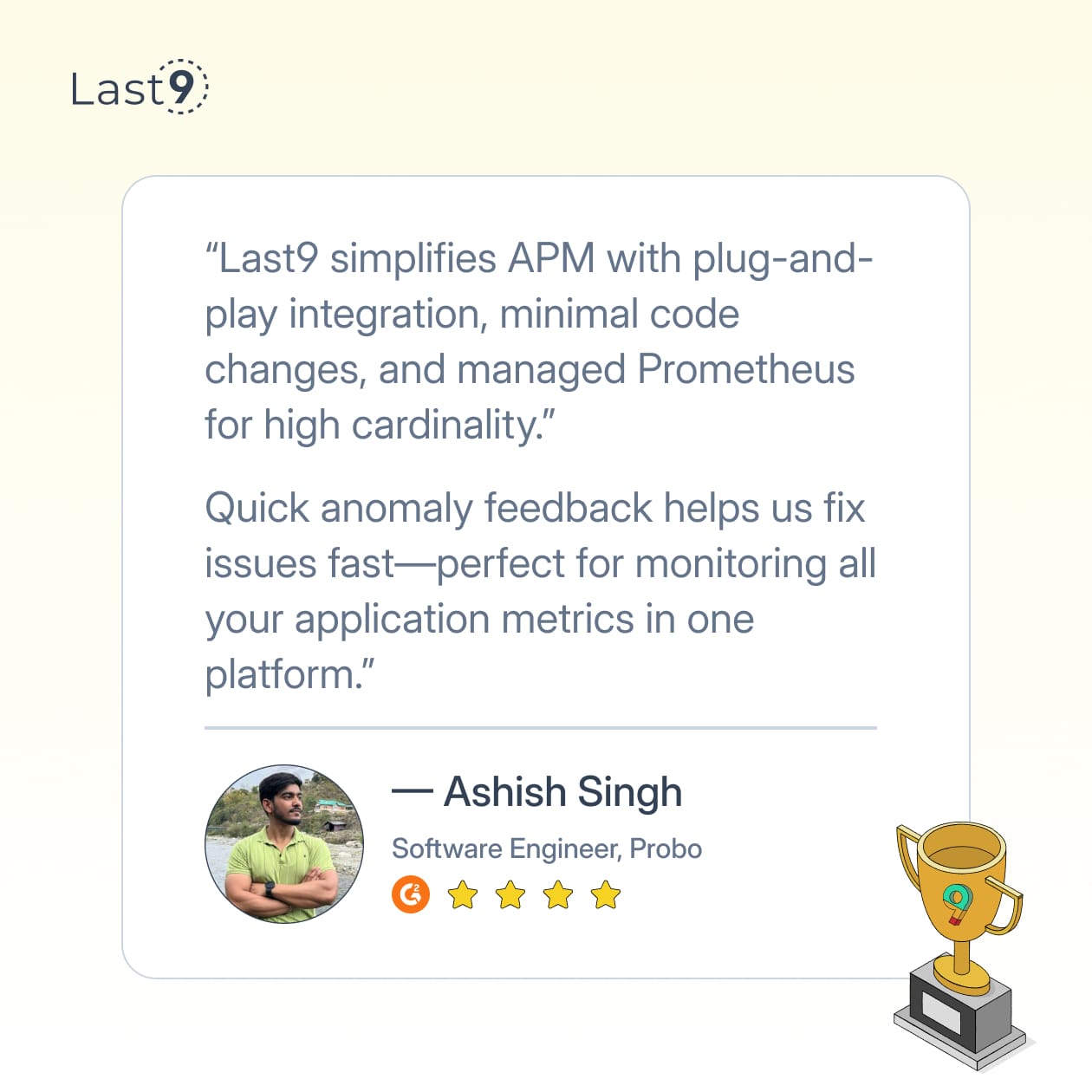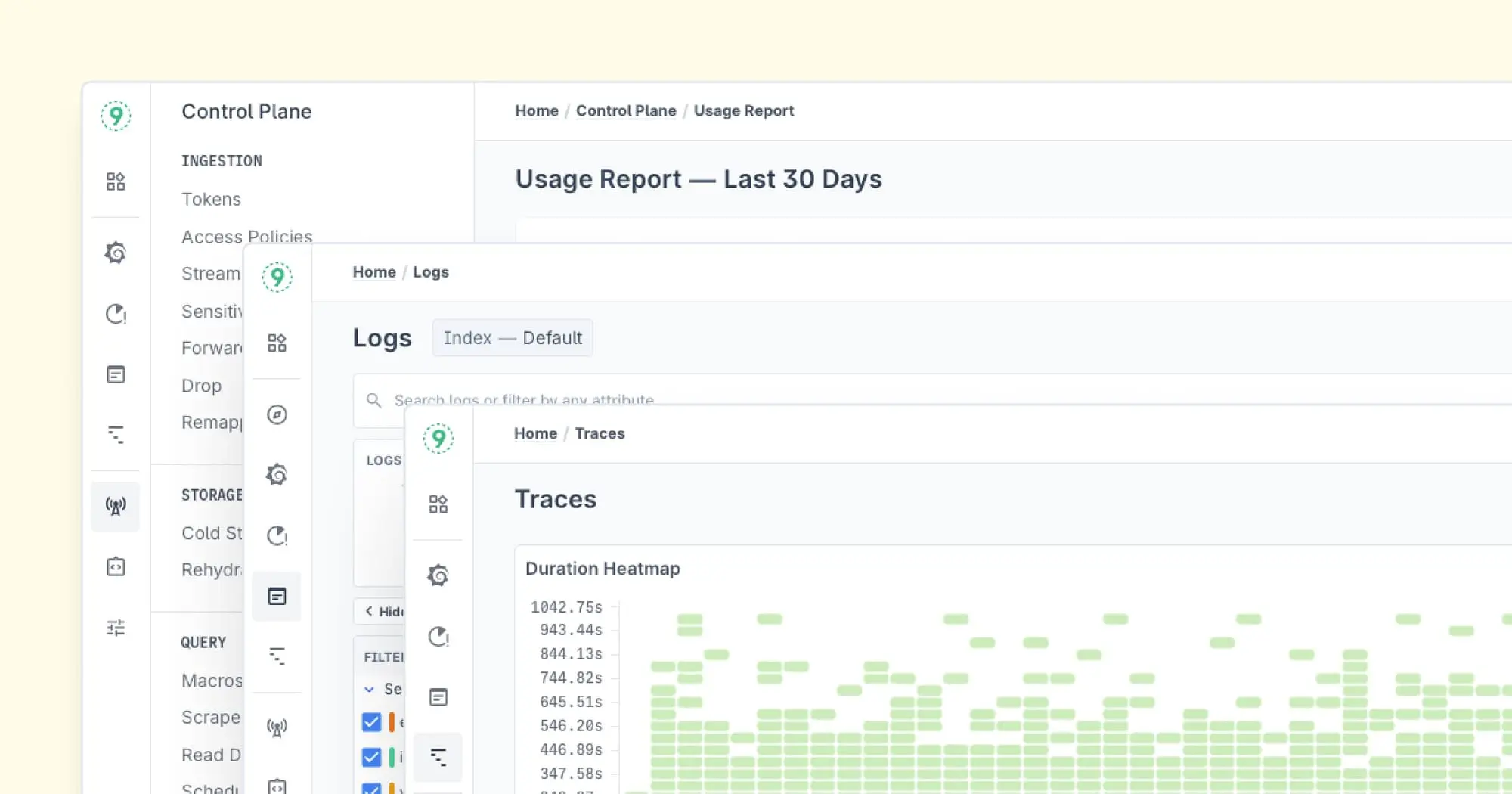Ensuring your enterprise network runs smoothly is key to both productivity and security. As businesses rely more on connected devices, applications, and cloud services, network monitoring has become a vital part of IT infrastructure.
Enterprise network monitoring tools offer valuable insights into the health, performance, and security of your network.
In this blog, we'll explore enterprise network monitoring tools, their benefits, how to choose the right one and highlight 7 popular options.
What Are Enterprise Network Monitoring Tools?
At their core, enterprise network monitoring tools are software solutions designed to keep an eye on the various aspects of a network. From servers and routers to applications and security measures, these tools provide a holistic view of your network’s performance.
The goal is to detect potential issues, optimize performance, and prevent downtime—before they disrupt your operations.
However, these tools aren’t just about monitoring. They can also offer valuable insights that enable IT teams to take proactive action and make data-driven decisions to improve the overall network infrastructure.
Key Features of Effective Enterprise Network Monitoring Tools
1. Real-time Monitoring
A top-notch network monitoring tool should provide real-time tracking of network traffic and performance. This ensures that IT teams can quickly identify any performance bottlenecks, outages, or security vulnerabilities. Real-time monitoring also helps in providing live updates, which is especially important for businesses that rely heavily on uptime for critical applications.
2. Network Topology Mapping
Understanding how all your network devices are connected and interact is crucial. With network topology mapping, enterprise tools give you a visual representation of your network’s layout. This not only helps in troubleshooting but also allows for better planning and capacity management.
3. Bandwidth Utilization
Monitoring how bandwidth is utilized across the network is essential for avoiding congestion. A good enterprise network monitoring tool will help you track bandwidth consumption and ensure that applications and users aren’t over-consuming resources, which could slow down the entire network.
4. Alerting and Notifications
Proactive alerts are key to network monitoring. Enterprise network monitoring tools are equipped to notify administrators immediately when there’s an issue, such as a performance dip or an abnormal traffic spike. Alerts can be customized for different severity levels, helping teams prioritize tasks efficiently.
5. Reporting and Analytics
Data-driven insights help IT teams make informed decisions. The best tools offer comprehensive reporting features, allowing users to generate detailed reports on network health, performance trends, and incidents. These reports are invaluable for optimizing network management and improving long-term performance.
Must-Have Network Monitoring Features You Can't Overlook
While most enterprise network monitoring tools offer standard features like real-time monitoring and alerting, some lesser-known features can make a significant impact on network management.
1. Deep Packet Inspection (DPI)
DPI monitors the actual content of network traffic, helping detect malware, data exfiltration, and unauthorized access. By going beyond basic packet headers, it uncovers hidden security threats.
2. Network Flow Analysis
Network flow analysis shows how data moves across your network, helping identify inefficient paths or malicious behavior. It’s a valuable tool for improving both performance and security.
3. Application Performance Monitoring (APM)
Applications often make up the majority of network traffic. Tools with APM capabilities monitor application health, pinpointing slowdowns and issues that may not be obvious from a network perspective.
4. Cloud Integration
With many businesses transitioning to hybrid or multi-cloud environments, network monitoring tools that integrate with cloud platforms offer a unified view of both on-premises and cloud-based components, enhancing visibility and management.
5. SD-WAN Monitoring
For businesses with distributed networks, SD-WANs require specialized monitoring tools to ensure reliable, secure, and high-performance connectivity between remote offices and branches.
8 Best Enterprise Network Monitoring Tools
When it comes to network monitoring, the tool you choose can make or break how smoothly your network runs.
So, we’ve rounded up seven of the best enterprise network monitoring tools to help you decide which one best fits your company’s needs.
Each of these tools offers unique features, pricing, and capabilities, so you’ll have all the information you need to make an informed decision.
1. Progress WhatsUp Gold
WhatsUp Gold by Progress is a powerful network monitoring solution designed to give you complete visibility into your IT infrastructure. From servers and applications to network devices and cloud resources, WhatsUp Gold helps you stay on top of performance and availability. Its interactive, map-based interface makes it easy to see issues at a glance and drill down for details.
If you want a solution that gives you complete visibility with an easy-to-navigate, map-based view of your entire network, WhatsUp Gold could be the right fit.
Best Features:
- Interactive Network Maps: Visualize your entire network in a dynamic, customizable map for better insight.
- Comprehensive Monitoring: Covers network devices, servers, applications, virtual environments, and cloud services.
- Customizable Alerts & Reporting: Create tailored alerts and in-depth reports to stay informed about what matters most.
- Flow & Bandwidth Monitoring: Track traffic patterns and bandwidth usage to optimize performance.
- Scalability: Suitable for small businesses up to large enterprises, with flexible add-ons for extended functionality.
- Ease of Setup: Users can set up and begin monitoring devices using WhatsUp Gold in as little as 30 minutes.
Limitations:
- Initial Learning Curve: The wide range of features can take time to fully master.
- Add-On Costs: Depending on your license type, advanced features like configuration or log management may require additional licensing.
- Interface Complexity: While powerful, the interface may feel overwhelming for first-time users.
When to Use:
WhatsUp Gold is ideal for businesses that need clear visibility of their network through an intuitive map-based approach. It’s particularly useful for teams that want strong out-of-the-box monitoring with the flexibility to expand into application, virtualization, and cloud environments as they grow.
Pricing:
WhatsUp Gold offers a flexible pricing model based on the number of monitored devices. There are both Perpetual and Subscription offers, with the Business tier starting at $1169 for 50 devices., WhatsUp Gold has many scalable options for larger networks and enterprise needs.
User Review:
Users appreciate WhatsUp Gold for its powerful visualization and depth of monitoring capabilities. Many highlight the interactive map as a standout feature for troubleshooting and day-to-day management, though some note that add-ons can increase costs quickly.
2.SolarWinds Network Performance Monitor
Intro:
SolarWinds is a top-tier network monitoring solution, particularly favored by large enterprises with intricate networks. Known for its scalability, it’s built to handle everything from performance monitoring to security alerts.
SolarWinds is one of those tools that shines when you need deep insights into your network and want to scale as your business grows.
Best Features:
- Scalability: Can handle networks of all sizes, making it perfect for large enterprises.
- Detailed Reporting: Offers comprehensive, customizable reports that provide a full picture of network performance.
- Real-Time Monitoring: Stay on top of issues as they happen with real-time data.
- Automated Alerts: Get notified immediately when something goes wrong—no need to constantly monitor manually.
- Customizable Dashboards: Tailor the interface to focus on what matters most to you.
Limitations:
- High Cost: SolarWinds is relatively expensive, especially for smaller businesses.
- Complex Setup: The initial setup can be time-consuming and requires some technical knowledge.
- Heavy on Resources: It can consume significant system resources, which could be an issue for smaller networks or systems with limited capacity.
When to Use:
SolarWinds is a great choice for large enterprises managing complex infrastructures and for IT teams that need a tool that can grow with their network. It's best suited for those who prioritize scalability, detailed reporting, and user-friendly dashboards.
Pricing:
SolarWinds starts at $12 per active network device or host. The cost scales up depending on the number of devices or hosts you’re monitoring, and additional features are available in higher pricing tiers.
User Review:
Users love SolarWinds for its powerful features and the ability to scale as needed. It’s easy to navigate once set up, but some users mention that the initial setup can take time and that the pricing might be a barrier for smaller businesses.
3. Paessler PRTG
Intro:
PRTG by Paessler is an all-in-one network monitoring solution that covers every aspect of your network—servers, bandwidth, cloud services, and more. What makes PRTG stand out is its ability to handle both on-premises and cloud-based systems with ease.
If you're looking for something that can monitor everything from the ground up, PRTG might be your go-to.
Best Features:
- Comprehensive Monitoring: PRTG covers everything from network devices to cloud services and bandwidth.
- Real-Time Tracking: Monitor network performance in real-time to quickly address any issues.
- Custom Alerts: Customize alerts so you're only notified about the most important events.
- Hybrid Cloud Support: Ideal for businesses with a hybrid IT setup, as it supports both on-premises and cloud environments.
- User-Friendly Interface: Even non-technical users can quickly get the hang of PRTG’s intuitive interface.
Limitations:
- Sensor Limitations: The free version only supports 100 sensors, so you’ll need to upgrade if you want to monitor more devices.
- Cost for Scaling: While the free version is handy for smaller networks, the paid versions can get expensive as your network grows.
- Resource Intensive: It can be resource-heavy, which may cause issues if your network is large or your hardware is limited.
When to Use:
PRTG is perfect for businesses that require flexibility, especially if you're managing both on-premises and cloud-based systems. It’s also a great fit for teams that want a robust, all-in-one tool that’s easy to use without sacrificing advanced features.
Pricing:
PRTG offers paid plans starting at $2,149 per year for 500 sensors, with options to scale for larger networks. Pricing varies based on the number of sensors you need, making it flexible for businesses of all sizes.
User Review:
PRTG is praised for being user-friendly and highly flexible. The free version is especially useful for small businesses, but some users suggest ensuring you have the proper hardware when scaling to larger environments.
4. Zabbix
Intro:
Zabbix is a favorite among open-source advocates and is one of the most customizable monitoring tools available.
It’s perfect for businesses with unique monitoring needs, particularly those that want to modify the tool to fit their infrastructure. If your team has strong technical expertise, Zabbix could be the perfect solution for you.
Best Features:
- Open-Source: Zabbix is completely free to use, which makes it great for companies that want to avoid high costs.
- Customization: Highly flexible with extensive options to tailor it to your needs.
- Wide Device Support: Supports many devices and platforms, making it ideal for complex environments.
- Real-Time Monitoring: Keeps tabs on your network’s performance at all times.
- Community Support: Zabbix has an active community, so troubleshooting is never far away.
Limitations:
- Steep Learning Curve: The tool can be intimidating for beginners and requires technical knowledge to configure properly.
- Limited Documentation: Although the community is active, official documentation could be more thorough, especially for advanced configurations.
- User Interface: Some users find the interface outdated and not as intuitive as other tools.
When to Use:
If you have a diverse, complex network and a team that is comfortable with technical configurations, Zabbix can be a fantastic, flexible solution. Its open-source nature makes it great for those who need extensive customization without the cost of licensing fees.
Pricing:
Zabbix is free to use, but commercial support plans are available if you need assistance.
User Review:
Zabbix is widely appreciated for its flexibility and power, especially by companies with the technical expertise to fully utilize its capabilities. However, its steep learning curve and reliance on community support can make it challenging for smaller teams or businesses new to network monitoring.
5. Nagios XI
Intro:
Nagios XI is known for its comprehensive monitoring capabilities, which cover everything from network devices to applications. It’s a go-to solution for enterprises that need full visibility across their network.
With an extensive plugin library, Nagios XI is a powerful, customizable tool for advanced users.
Best Features:
- Comprehensive Monitoring: Monitor everything from servers and applications to network devices.
- Plugins and Extensions: The huge plugin library lets you extend Nagios’ functionality to cover any aspect of your network.
- Alerting and Escalation: Advanced alerting capabilities, with the ability to escalate issues for faster resolution.
- Custom Dashboards: Build dashboards that focus on the metrics that matter most to your team.
Limitations:
- Complex Setup: Setting up Nagios XI can be difficult and time-consuming, especially for beginners.
- Clunky Interface: The user interface is often described as outdated and not as polished as other modern tools.
- Limited Documentation for Advanced Features: The extensive plugin library is great, but navigating through it can be difficult without solid documentation.
When to Use:
Best suited for businesses that need detailed monitoring across multiple devices and applications and who want to tailor the monitoring experience to their specific needs. If customization and extensibility are important to you, Nagios XI is a solid option.
Pricing:
Nagios XI starts at $3,990 for the base version with 50 nodes, with additional costs for advanced features and plugins as your network grows or your needs become more complex.
User Review:
Nagios XI is highly valued for its depth and flexibility. However, some users feel that the interface is a bit dated, and it’s not the most intuitive tool for beginners. It’s best suited for teams with more technical experience.
6. ManageEngine OpManager
Intro:
OpManager is known for being intuitive and easy to use while providing advanced network monitoring features. It offers end-to-end monitoring for both physical and virtual networks, and its automated discovery and configuration features make it a huge time-saver for IT teams.
Best Features:
- Automated Discovery: Automatically maps and discovers devices in your network, saving you time during setup.
- Advanced Analytics: Get insights into network health and performance, along with detailed reporting.
- Customizable Maps: Build visual network maps that make it easier to understand the layout of your infrastructure.
- Third-Party Integrations: Seamlessly integrates with other tools and systems you may already use.
Limitations:
- Pricing Tiers: Some advanced features are locked behind higher-tier plans, which could make scaling more expensive.
- Limited Device Support: While it supports a wide range of devices, there are some limitations for very specific or niche devices.
- Interface Overload: The interface can become overwhelming due to the large number of options, especially for new users.
When to Use:
OpManager is ideal for businesses that want a user-friendly tool with powerful automation and analytics. It’s perfect for large, dynamic networks, especially if you're managing a mix of physical, virtual, and cloud environments.
Pricing:
OpManager starts at $245 per year for the Standard edition, with higher-tier plans offering additional features and scalability.
User Review:
OpManager is praised for its ease of use, intuitive interface, and powerful automation features. Some users, however, find the setup a bit challenging if they don’t have a lot of network management experience.

7. Auvik
Intro:
Auvik is a cloud-based network monitoring tool that focuses on simplifying network management. Its user-friendly interface and automation capabilities make it ideal for small to medium-sized businesses that need remote monitoring and quick troubleshooting.
Best Features:
- Cloud-Based Monitoring: Monitor your network from anywhere with Auvik’s cloud solution.
- Automated Mapping: Auvik automatically maps your network, so you don’t have to manually configure everything.
- Real-Time Insights: Get real-time visibility into network performance and health.
- Intuitive Dashboard: The dashboard is highly customizable, letting you focus on the metrics you care about.
Limitations:
- Limited Advanced Features: Auvik’s simplicity can be a limitation for larger enterprises that need highly customizable or advanced monitoring features.
- Pricing: Auvik can be more expensive compared to other tools, which may not make it the best choice for smaller businesses with limited budgets.
- Cloud Reliance: Since it’s a cloud-based solution, it might not be ideal for businesses that prefer on-premises solutions for data security or privacy reasons.
When to Use:
Great for small to medium-sized businesses that want a simple, cloud-based solution for network monitoring. Auvik is perfect for companies with lean IT teams that need something easy to use yet powerful.
Pricing:
Auvik charges based on the number of billable devices on your networks. Pricing scales with the size of your network, making it a flexible option for businesses of different sizes.
User Review:
Auvik is often praised for its ease of use and cloud-based features. It’s particularly appreciated by companies that don’t have large IT teams. The downside is that some users feel it’s a bit pricey for smaller businesses.
8. Datadog
Intro:
Datadog is a cloud-based platform that provides full-stack monitoring, covering everything from applications to infrastructure and network performance. It’s best suited for cloud-native environments, where real-time data and advanced analytics are key.
Best Features:
- Full-Stack Monitoring: Get insights into your entire tech stack, including apps, infrastructure, and networks.
- Real-Time Analytics: Datadog excels at offering real-time data visualization and analytics to identify issues before they become problems.
- Advanced Integrations: Integrate with a wide range of cloud services and applications to enhance your monitoring capabilities.
- AIOps: Datadog uses artificial intelligence for intelligent automation and anomaly detection.
Limitations:
- Costly: Datadog’s pricing model can be quite expensive, particularly for larger organizations with many hosts or additional features.
- Overwhelming for Small Teams: Due to its vast array of features and integrations, it may be overwhelming for small IT teams to manage effectively.
- Learning Curve: While it’s powerful, there can be a bit of a learning curve for users new to the platform.
When to Use:
Datadog is perfect for enterprises that rely heavily on cloud infrastructure and need advanced analytics, real-time insights, and integration with other cloud-based services.
Pricing:
Datadog’s infrastructure monitoring starts at $15 per host per month, with additional costs for features like APM, logs, and synthetic monitoring.
User Review:
Datadog is widely praised for its powerful integrations and real-time analytics, making it a favorite in cloud-native environments. However, its high pricing and lack of robust support often leave users frustrated, especially when troubleshooting complex issues. These factors can make it a less ideal choice for smaller businesses or teams with limited budgets and resources.

Challenges to Consider When Choosing a Network Monitoring Tool
Choosing the right network monitoring tool can be tricky. Here are some common challenges businesses face:
1. Scalability
As your business grows, so do your network needs. Not all tools scale well with an expanding network, so it’s important to pick one that can grow with your infrastructure.
2. Integration
Enterprise networks often consist of diverse devices and platforms. The right tool should integrate smoothly with your existing hardware and software to avoid any gaps in monitoring.
3. Complexity of Use
Some network monitoring tools can be complex and require extensive training. Choosing tools with intuitive dashboards can make implementation smoother.
4. Cost
The price of network monitoring tools can vary. It's essential to consider the total cost of ownership, including licensing, maintenance, and support, to ensure you’re getting good value.
Which Tool Is Right for You?
Choosing the right network monitoring tool depends on several factors, such as the size of your business, the complexity of your network, and your budget.
- If you need a scalable solution with detailed insights, SolarWinds or PRTG could be the right fit.
- For more budget-conscious users, Zabbix offers great flexibility, especially if you're comfortable with its configuration.
- Meanwhile, Auvik and OpManager stand out for their ease of use.
If you're looking for a unified observability solution, Last9 brings full-stack observability to your fingertips.
Trusted by industry leaders like Games24x7, CleverTap, and Replit, Last9 is a Telemetry Data Platform that optimizes cloud-native monitoring by balancing performance, cost, and user experience.
Last9 integrates easily with tools like OpenTelemetry, Prometheus, and others to unify metrics, logs, and traces, efficiently managing high-cardinality data. With features like smart alerting and real-time metrics through its Control Plane, Last9 empowers engineering teams to gain deeper insights and enhance operational intelligence.
Schedule a demo with us to explore how Last9 can help boost observability while keeping your costs in check!



